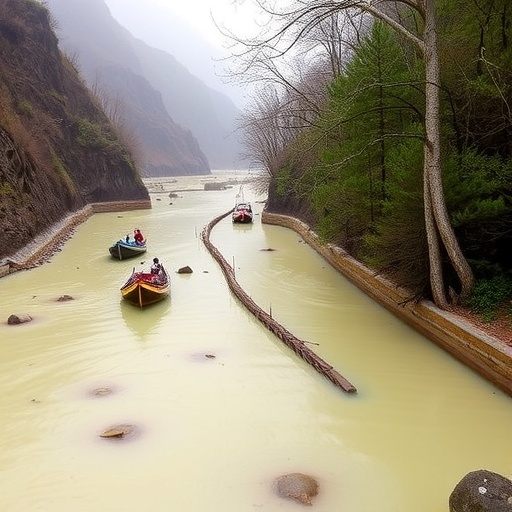In a groundbreaking study, researchers have unveiled crucial insights into methane emissions from riverine ecosystems within the Yangtze River basin. The findings indicate that ebullition—a process characterized by the rapid release of gas bubbles from sediment—plays a more significant role in methane emissions than previously understood diffusion processes. This research offers potential implications for understanding greenhouse gas contributions from freshwater ecosystems and emphasizes the need to reassess how we measure and model methane contributions.
The Yangtze River basin is one of the most vital freshwater ecosystems in the world, supporting a rich biodiversity and providing essential resources for the surrounding human populations. However, it is also an area significantly impacted by human activities—urbanization, agriculture, and industrial developments are prevalent along its banks. With these activities comes the potential increase in greenhouse gas emissions, particularly methane, which is a potent contributor to climate change.
Previous studies have largely focused on methane being released through diffusion—where the gas moves from an area of higher concentration to one of lower concentration. This understanding has been foundational in evaluations of methane emissions in aquatic systems. However, Chen et al. challenge this premise, presenting evidence that ebullition could account for a larger share of the total methane emissions from riverine ecosystems in the Yangtze River basin.
The research team conducted extensive field studies, employing water and sediment sampling procedures that allowed them to measure methane levels accurately. Their methodology was both comprehensive and innovative, tracking methane concentrations in the water column, sediment layers, and the atmospheric interfaces. The use of advanced analytical techniques ensured that their measurements were precise, which is vital for accurately evaluating greenhouse gas emissions.
One particularly striking finding of the study is that certain zones in the Yangtze River basin exhibited powerful ebullition events. These events occur when methane accumulated within sediments suddenly escapes into the water column, creating visible bubbles. While researchers had previously acknowledged ebullition, Chen and colleagues provide data showing that this mechanism can result in rapid, large-scale methane release that far exceeds that of slow diffusion processes.
This significant revelation raises several critical questions about our understanding of riverine methane dynamics. For environmental scientists, it calls for a rethinking of current models that predict greenhouse gas emissions from freshwater ecosystems. With the volume of methane released through ebullition being estimated as substantially higher than diffusion, there may be a pressing need to incorporate ebullition into future climate models.
The implications of this research extend beyond theoretical understanding—it contributes crucial knowledge that can inform policies and practices aimed at mitigating climate change. Methane is recognized for its potency as a greenhouse gas, being significantly more effective at trapping heat in the atmosphere compared to carbon dioxide over a short time frame. Thus, understanding where and how much methane is released from river systems helps us strategize more effective climate action frameworks.
Furthermore, public awareness surrounding ecosystem management is increasingly vital in the face of climate challenges. The Yangtze River basin’s ecosystem faces threats from pollution and habitat degradation due to anthropogenic pressures. Understanding methane emissions could influence conservation strategies, prompting a focus on protecting riverine environments as a means of climate change mitigation.
One of the fascinating aspects of the research is its interdisciplinary nature. It combines elements of environmental science, chemistry, and ecology, illustrating the importance of collaborative work in tackling complex global issues. The collaboration of chemists, ecologists, and environmental scientists in this study demonstrates the collective effort required to address multifaceted environmental challenges, opening pathways for similar integrative approaches in future research.
Moreover, Chen et al.’s study opens up avenues for further research into the mechanisms that govern ebullition. Investigating the specific sediment characteristics that promote ebullition, such as organic matter composition and sediment structure, could provide additional insights into how these emissions can vary across different riverine environments. Understanding these dynamics is crucial for developing targeted interventions aimed at managing and reducing methane emissions.
As researchers worldwide keep a close eye on freshwater systems, the findings from the Yangtze River basin could be used as a case study for similar environments affected by human activity. If similar patterns of ebullition-driven methane emissions are detected in other river systems, it might fundamentally alter how scientists and policymakers assess the impacts of freshwater ecosystems on climate change trajectories.
Overall, this research complements the growing body of literature that emphasizes the significance of nonlinear processes in greenhouse gas emissions. At a time when climate change impacts are intensifying, understanding each contributing factor becomes all the more essential. The nuanced lens through which Chen et al. view methane emissions adds not only to scientific knowledge but also to global conversations about environmental stewardship.
As the importance of tackling climate change remains at the forefront of global discourse, studies like this one shine a light on specific mechanisms that require attention. The emphasis on ebullition reinforces the idea that every detail counts in the narrative of climate resilience, urging stakeholders—from scientists to policymakers—to embrace a more granular approach in conserving and managing our precious freshwater ecosystems.
In conclusion, Chen, Sun, Li, and their colleagues have made a significant contribution to our understanding of methane emissions from riverine ecosystems. Their findings invite a reevaluation of existing models and underscore the urgency for research that can guide effective climate action and ecosystem management in the face of ongoing environmental challenges.
Subject of Research: Methane emissions from riverine ecosystems in the Yangtze River basin
Article Title: Methane emissions from riverine ecosystems in the Yangtze River basin are driven by ebullition rather than diffusion.
Article References:
Chen, X., Sun, F., Li, J. et al. Methane emissions from riverine ecosystems in the Yangtze River basin are driven by ebullition rather than diffusion.
Commun Earth Environ 6, 680 (2025). https://doi.org/10.1038/s43247-025-02653-y
Image Credits: AI Generated
DOI: 10.1038/s43247-025-02653-y
Keywords: Methane emissions, riverine ecosystems, Yangtze River basin, ebullition, diffusion, greenhouse gases, climate change.




